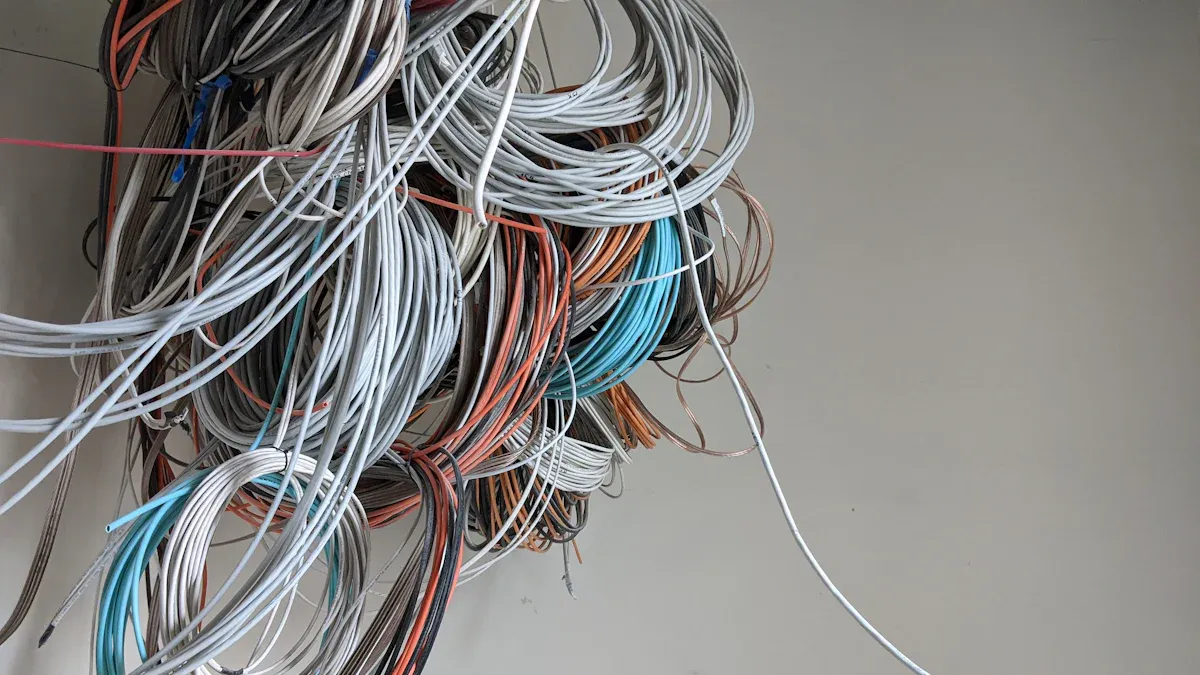PET Heat Shrink Tubing vs Electrical Tape for Insulation

Electrical insulation plays a critical role in ensuring the safety and efficiency of wiring systems. PET Heat Shrink Tubing for electrical insulation provides a durable, secure, and high-performance solution. Its ability to conform tightly to wires enhances protection against environmental factors. On the other hand, electrical tape offers flexibility and affordability, making it suitable for quick fixes or temporary applications. Each material serves distinct purposes, and understanding their properties helps in selecting the right option for specific needs.
Key Takeaways
Pick PET heat shrink tubing for long-lasting insulation. It is strong and protects well from water and chemicals.
Use electrical tape for quick and short-term fixes. It is easy to use and works for simple jobs.
Think about the job when choosing insulation. PET heat shrink tubing works great in tough conditions, while electrical tape is good for daily tasks.
Compare cost and quality. Electrical tape costs less, but PET heat shrink tubing lasts longer and is worth it over time.
Know that PET heat shrink tubing needs heat to work, but electrical tape can be put on by hand.
PET Heat Shrink Tubing for Electrical Insulation

Material Composition and Properties
PET heat shrink tubing for electrical insulation is crafted from polyethylene terephthalate (PET), a material renowned for its durability and moisture resistance. This composition ensures the tubing can withstand exposure to harsh environmental conditions, making it ideal for protecting electronic components. Its ability to form a tight seal around wires and connectors prevents water ingress, reducing the risk of rust and corrosion. Additionally, PET exhibits excellent chemical resistance, allowing it to endure contact with various corrosive substances. These properties make PET heat shrink tubing a reliable choice for preventing short circuits and safeguarding electrical systems from damage. The tubing’s snug fit creates a secure barrier, ensuring no accidental contact occurs between conductive parts.
How Heat Shrink Tubing Works
Heat shrink tubing operates through a straightforward yet effective process. When exposed to heat, the tubing contracts and conforms tightly to the shape of the underlying wires or connectors. This shrinkage occurs due to the material's thermoplastic properties, which allow it to return to its original, pre-expanded state. The result is a seamless layer of insulation that protects against environmental factors such as moisture, dust, and mechanical stress. For added functionality, adhesive-lined heat shrink tubing includes an inner layer of adhesive that melts during the heating process. This creates a watertight seal, enhancing the tubing’s ability to provide long-lasting protection in demanding applications.
Common Applications of PET Heat Shrink Tubing
PET heat shrink tubing for electrical insulation serves a wide range of industries due to its versatility and robust properties. Common applications include:
Healthcare: Protects electronic components in medical devices from environmental hazards.
Automotive: Shields wiring and connectors from moisture and corrosion in vehicles.
Aerospace: Ensures the reliability of electronic systems in aircraft by providing insulation and protection.
Industrial Automation: Safeguards electrical systems in machinery from harsh conditions.
Power Distribution Systems: Provides insulation to ensure safety and operational efficiency.
The industrial sector represents the largest user of flame-retardant heat shrink tubing. This highlights the growing demand for robust insulation solutions capable of withstanding mechanical stress and chemical exposure. PET heat shrink tubing’s ability to deliver reliable performance across diverse environments makes it a preferred choice for professionals in these fields.
Electrical Tape for Insulation
Material Composition and Properties
Electrical tape is crafted from a combination of flexible and durable materials, each contributing to its performance. The table below highlights the key components and their roles:
Material | Contribution to Flexibility and Insulation Properties |
|---|---|
Vinyl | Offers flexibility, durability, and resistance to moisture, UV rays, and corrosion. |
Rubber | Provides excellent insulation and resistance to extreme temperatures, ideal for high-voltage applications. |
Mastic | Features a thick adhesive for superior moisture sealing, suitable for outdoor or underground use. |
Varnished Cambric | Made from cotton cloth with varnish, providing high mechanical strength and chemical resistance for industrial use. |
These materials ensure electrical tape remains versatile and effective in various applications, from household wiring to industrial systems.
How Electrical Tape Works
Electrical tape functions as both an adhesive and an insulator. Its rubber-based adhesive forms a strong bond with surfaces, ensuring the tape stays securely in place. The insulating backing material, typically vinyl, creates a protective barrier that prevents electrical leakage and enhances safety. When applied, the tape wraps tightly around wires or connectors, providing a seamless layer of insulation. This process safeguards against moisture, abrasion, and temperature fluctuations. High-quality electrical tape maintains its integrity under stress, ensuring long-lasting performance in demanding environments.
Common Applications of Electrical Tape
Electrical tape serves multiple purposes across industries. Its primary applications include:
Insulating: Wrapping split bolt connectors or other tapes to form an insulated outer barrier.
Splicing: Safely joining wires together.
Marking: Using standardized colors for phase marking wires and maintaining a clear workspace.
Additional benefits include excellent dielectric strength, weather resistance, and durability against high temperatures and moisture. Electrical tape is widely used in:
Electrical and electronics industries.
Household wiring.
Automotive repairs.
General-purpose electrical repairs.
Its versatility and reliability make it an essential tool for professionals and DIY enthusiasts alike.
Comparing PET Heat Shrink Tubing and Electrical Tape

Insulation Performance
PET heat shrink tubing offers superior insulation by forming a tight, seamless barrier around wires and connectors. Its ability to conform to irregular shapes ensures complete coverage, reducing the risk of electrical leakage. The material's resistance to moisture, chemicals, and UV exposure enhances its effectiveness in harsh environments. This makes it an excellent choice for long-term applications where reliability is critical.
Electrical tape, while effective for basic insulation needs, provides a less secure fit. Its flexibility allows it to wrap around wires easily, but gaps or overlaps can compromise its insulating properties. Over time, exposure to environmental factors may degrade the tape, reducing its effectiveness. For temporary fixes or low-stress applications, electrical tape remains a practical option. However, for high-performance insulation, PET heat shrink tubing outshines its counterpart.
Durability and Longevity
The durability of PET heat shrink tubing surpasses that of electrical tape. It forms a permanent bond that withstands mechanical stress, abrasion, and exposure to chemicals. Its longevity ensures consistent performance, even in extreme conditions. In contrast, electrical tape's adhesive properties weaken over time, especially in harsh environments. The table below highlights key differences in durability and longevity:
Feature | PET Heat Shrink Tubing | Electrical Tape |
|---|---|---|
Bonding | Forms a permanent, durable bond | Adhesive properties can weaken over time |
Environmental Resistance | Withstands chemicals, abrasion, moisture, UV | Prone to degradation in harsh environments |
Longevity | High long-term reliability | Less suitable for extreme conditions |
For applications requiring long-term reliability, PET heat shrink tubing is the preferred choice.
Ease of Application
Electrical tape is easy to apply and remove, making it ideal for temporary fixes and quick repairs. Its flexibility allows users to wrap it around wires without specialized tools. This convenience makes it a go-to option for DIY enthusiasts and professionals handling minor repairs.
PET heat shrink tubing, on the other hand, requires heat for application. This process involves using a heat gun or similar tool to shrink the tubing around the wires. While this step adds complexity, it results in a durable, long-lasting bond. For projects demanding high-performance insulation, the additional effort is worthwhile.
Tip: Use electrical tape for quick fixes and PET heat shrink tubing for permanent solutions.
Cost Comparison
Cost is a significant factor when choosing between PET heat shrink tubing and electrical tape. Electrical tape is generally more affordable, making it an attractive option for budget-conscious users or projects requiring large quantities. Its lower price point allows for widespread use in household repairs, temporary fixes, and general-purpose applications.
PET heat shrink tubing, while more expensive upfront, offers better value for long-term applications. Its durability and resistance to environmental factors reduce the need for frequent replacements, saving costs over time. Additionally, specialized types of heat shrink tubing, such as adhesive-lined or flame-retardant variants, may increase the initial investment but provide enhanced performance in demanding environments.
The choice between these materials depends on the project's budget and requirements. For short-term or low-stress applications, electrical tape provides a cost-effective solution. However, for critical systems where reliability and longevity are paramount, PET heat shrink tubing justifies its higher price.
Specific Use Cases
PET heat shrink tubing and electrical tape excel in different scenarios due to their unique properties. PET heat shrink tubing is indispensable for applications requiring high-performance insulation and durability. It minimizes risks of short circuits and electrical damage, particularly in critical fields like medical devices and aerospace systems. Its ability to conform tightly to components creates a secure barrier, ensuring the safety and efficiency of electronic systems.
Electrical tape, on the other hand, is ideal for basic insulation tasks and temporary repairs. It is commonly used for splicing wires, marking cables, and providing quick fixes in household or automotive settings. Its flexibility and ease of application make it a practical choice for non-critical applications.
The table below highlights the strengths of each material in specific use cases:
Feature/Use Case | PET Heat Shrink Tubing | Electrical Tape |
|---|---|---|
Insulation | Provides superior insulation for electrical components | Basic insulation, less reliable |
Durability | Highly durable, resistant to chemicals and abrasion | Less durable, can wear out quickly |
Application Flexibility | Versatile for various applications including strain relief and environmental protection | Limited to basic electrical applications |
Military Standards | Specialized types meet military standards for reliability | No military-grade options available |
PET heat shrink tubing is particularly suited for strain relief, wire bundling, environmental protection, and identification. Electrical tape remains a go-to option for temporary repairs and preventative maintenance.
Tip: For critical systems requiring long-term reliability, PET heat shrink tubing is the better choice. Electrical tape works well for quick, low-cost fixes.
Choosing Between PET Heat Shrink Tubing and Electrical Tape
When to Use PET Heat Shrink Tubing
PET heat shrink tubing is the preferred choice for applications requiring high durability and reliable insulation. Its ability to conform tightly to wires and connectors ensures superior protection against environmental factors such as moisture, chemicals, and UV exposure. This makes it ideal for industries like healthcare, automotive, and aerospace, where performance and safety are critical.
The decision to use PET heat shrink tubing often depends on specific performance criteria and application scenarios. The table below highlights these considerations:
Performance Criteria | Application Scenarios |
|---|---|
Durability | Healthcare |
Electrical insulation properties | Automotive |
Resistance to environmental factors | Aerospace |
Cost-effectiveness | Various industries |
For long-term projects or environments with harsh conditions, PET heat shrink tubing offers unmatched reliability. Its ability to provide strain relief and environmental protection further enhances its value in critical systems.
Tip: Use PET heat shrink tubing for permanent solutions where durability and high-performance insulation are essential.
When to Use Electrical Tape
Electrical tape is a practical option for temporary fixes and general-purpose insulation tasks. Its flexibility and ease of application make it suitable for quick repairs, splicing wires, or marking cables. Professionals and DIY enthusiasts often rely on electrical tape for its affordability and versatility.
When selecting electrical tape, several criteria should guide the decision. The table below outlines key factors to consider:
Criteria | Description |
|---|---|
Adhesion | The ability of the tape to stick to surfaces effectively. |
Breaking Strength | The maximum stress the tape can withstand before failing. |
Elasticity | The tape's ability to stretch without breaking, important for applications with movement. |
Dielectric Properties | The tape's effectiveness in insulating against electrical breakdown. |
Heat Resistance | The capability of the tape to maintain performance under high temperatures. |
Chemical Resistance | The tape's ability to resist degradation from chemicals it may encounter in various environments. |
Electrical tape works well for non-critical applications, such as household wiring or automotive repairs. Its cost-effectiveness and ease of use make it a go-to solution for temporary insulation needs.
Note: Electrical tape is best suited for short-term fixes or low-stress environments where frequent replacements are acceptable.
PET heat shrink tubing excels in applications demanding high durability and reliable insulation. Its ability to provide a secure fit and long-lasting performance makes it the preferred choice for critical and long-term projects. Electrical tape, however, offers a flexible and cost-effective solution for temporary fixes and general-purpose tasks.
When selecting between these materials, users should evaluate their specific insulation requirements. Factors such as durability, cost, and application type play a crucial role in determining the most suitable option. By understanding the strengths of each material, professionals can ensure optimal performance and safety in their electrical systems.
FAQ
What is the main difference between PET heat shrink tubing and electrical tape?
PET heat shrink tubing provides a durable, secure fit and superior insulation for long-term applications. Electrical tape offers flexibility and affordability, making it suitable for temporary fixes or general-purpose tasks. Each material serves distinct purposes based on insulation needs.
Can PET heat shrink tubing be reused after application?
No, PET heat shrink tubing cannot be reused. Once it shrinks and conforms to the wires, it forms a permanent bond. Removing it requires cutting, which makes reapplication impossible. For reusable insulation, electrical tape is a better option.
Is electrical tape safe for high-voltage applications?
Electrical tape can handle high-voltage applications if it meets specific standards, such as UL or CSA certifications. However, it may degrade over time in harsh conditions. PET heat shrink tubing offers better long-term reliability for high-voltage systems.
Does PET heat shrink tubing require special tools for installation?
Yes, PET heat shrink tubing requires a heat source, such as a heat gun, for proper installation. The heat causes the tubing to shrink and conform to the wires. Electrical tape, in contrast, does not need any tools and can be applied manually.
Which material is more environmentally friendly?
PET heat shrink tubing is often more environmentally friendly due to its durability and reduced need for frequent replacements. Electrical tape, while cost-effective, may contribute to more waste over time due to its shorter lifespan and frequent disposal.
Tip: Consider the environmental impact of your insulation choice, especially for long-term projects.
See Also
Exploring Heat Shrink Tubing Applications for Electrical Insulation
Essential Insights on PET Heat Shrink Tubing for Electronics
Comparative Analysis of FEP Heat Shrink Tubing Brands
Differences Between Medical and Industrial Grade Heat Shrink Tubing

